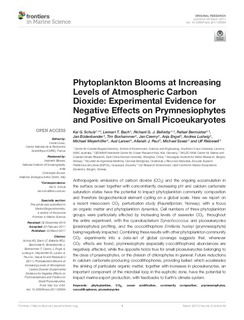| dc.contributor.author | Schulz, Kai G. | |
| dc.contributor.author | Bach, Lennart T. | |
| dc.contributor.author | Bellerby, Richard G. J | |
| dc.contributor.author | Bermúdez, Rafael | |
| dc.contributor.author | Büdenbender, Jan | |
| dc.contributor.author | Boxhammer, Tim | |
| dc.contributor.author | Czerny, Jan | |
| dc.contributor.author | Engel, Anja | |
| dc.contributor.author | Ludwig, Andrea | |
| dc.contributor.author | Meyerhöfer, Michael | |
| dc.contributor.author | Larsen, Aud | |
| dc.contributor.author | Paul, Allanah J. | |
| dc.contributor.author | Sswat, Michael | |
| dc.contributor.author | Riebesell, Ulf | |
| dc.date.accessioned | 2018-08-02T12:06:47Z | |
| dc.date.available | 2018-08-02T12:06:47Z | |
| dc.date.created | 2017-11-29T13:40:12Z | |
| dc.date.issued | 2017 | |
| dc.identifier.citation | Frontiers in Marine Science. 2017, 4, 18: 64. | nb_NO |
| dc.identifier.issn | 2296-7745 | |
| dc.identifier.uri | http://hdl.handle.net/11250/2507283 | |
| dc.description.abstract | Anthropogenic emissions of carbon dioxide (CO2) and the ongoing accumulation in the surface ocean together with concomitantly decreasing pH and calcium carbonate saturation states have the potential to impact phytoplankton community composition and therefore biogeochemical element cycling on a global scale. Here we report on a recent mesocosm CO2 perturbation study (Raunefjorden, Norway), with a focus on organic matter and phytoplankton dynamics. Cell numbers of three phytoplankton groups were particularly affected by increasing levels of seawater CO2 throughout the entire experiment, with the cyanobacterium Synechococcus and picoeukaryotes (prasinophytes) profiting, and the coccolithophore Emiliania huxleyi (prymnesiophyte) being negatively impacted. Combining these results with other phytoplankton community CO2 experiments into a data-set of global coverage suggests that, whenever CO2 effects are found, prymnesiophyte (especially coccolithophore) abundances are negatively affected, while the opposite holds true for small picoeukaryotes belonging to the class of prasinophytes, or the division of chlorophytes in general. Future reductions in calcium carbonate-producing coccolithophores, providing ballast which accelerates the sinking of particulate organic matter, together with increases in picoeukaryotes, an important component of the microbial loop in the euphotic zone, have the potential to impact marine export production, with feedbacks to Earth’s climate system. | nb_NO |
| dc.language.iso | eng | nb_NO |
| dc.publisher | Frontiers Media | nb_NO |
| dc.rights | Navngivelse 4.0 Internasjonal | * |
| dc.rights.uri | http://creativecommons.org/licenses/by/4.0/deed.no | * |
| dc.title | Phytoplankton Blooms at Increasing Levels of Atmospheric Carbon Dioxide: Experimental Evidence for Negative Effects on Prymnesiophytes and Positive on Small Picoeukaryotes | nb_NO |
| dc.type | Journal article | nb_NO |
| dc.type | Peer reviewed | nb_NO |
| dc.description.version | publishedVersion | nb_NO |
| dc.rights.holder | Copyright © 2017 Schulz, Bach, Bellerby, Bermúdez, Büdenbender, Boxhammer, Czerny, Engel, Ludwig, Meyerhöfer, Larsen, Paul, Sswat and Riebesell. | nb_NO |
| dc.source.pagenumber | 18 | nb_NO |
| dc.source.volume | 4 | nb_NO |
| dc.source.journal | Frontiers in Marine Science | nb_NO |
| dc.identifier.doi | 10.3389/fmars.2017.00064 | |
| dc.identifier.cristin | 1520267 | |
| dc.relation.project | EC/FP7/250254 | nb_NO |
| dc.relation.project | EC/FP7/264933 | nb_NO |
| dc.relation.project | German Ministry for Education and Research | nb_NO |
| dc.relation.project | Australian Research Council: FT120100384 | nb_NO |
| dc.relation.project | Bjerknes Centre for Climate Research | nb_NO |
| cristin.unitcode | 7464,20,14,0 | |
| cristin.unitname | Marin biogeokjemi og oseanografi | |
| cristin.ispublished | true | |
| cristin.fulltext | original | |
| cristin.qualitycode | 1 | |

